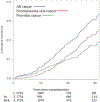Pediatric Kidney Transplantation: Cancer and Cancer Risk
- PMID: 38580568
- PMCID: PMC11734768
- DOI: 10.1016/j.semnephrol.2024.151501
Pediatric Kidney Transplantation: Cancer and Cancer Risk
Abstract
Children with end-stage kidney disease (ESKD) face a lifetime of complex medical care, alternating between maintenance chronic dialysis and kidney transplantation. Kidney transplantation has emerged as the optimal treatment of ESKD for children and provides important quality of life and survival advantages. Although transplantation is the preferred therapy, lifetime exposure to immunosuppression among children with ESKD is associated with increased morbidity, including an increased risk of cancer. Following pediatric kidney transplantation, cancer events occurring during childhood or young adulthood can be divided into two broad categories: post-transplant lymphoproliferative disorders and non-lymphoproliferative solid tumors. This review provides an overview of cancer incidence, types, outcomes, and preventive strategies in this population.
Keywords: Cancer; kidney transplant; pediatric; post-transplant lymphoproliferative disorder.
Copyright © 2024 Elsevier Inc. All rights reserved.
Conflict of interest statement
Financial disclosure and conflict of interest statements: none.
Figures



References
-
- Bonthuis M, Groothoff JW, Ariceta G, et al. Growth patterns after kidney transplantation in European children over the past 25 years: an ESPN/ERA-EDTA registry study. Transplantation. 2020;104(1):137–44. - PubMed
-
- Guha C, van Zwieten A, Khalid R, et al. Longitudinal assessment of the health-related quality of life of children and adolescents with chronic kidney disease. Kidney Int. 2023;103(2):357–64. - PubMed
-
- Gillen DL, Stehman-Breen CO, Smith JM, et al. Survival advantage of pediatric recipients of a first kidney transplant among children awaiting kidney transplantation. Am J Transplant. 2008;8(12):2600–6. - PubMed
-
- McDonald SP, Craig JC. Long-term survival of children with end-stage renal disease. N Engl J Med. 2004;350(26):2654–62. - PubMed
Publication types
MeSH terms
Substances
Grants and funding
LinkOut - more resources
Full Text Sources
Medical

